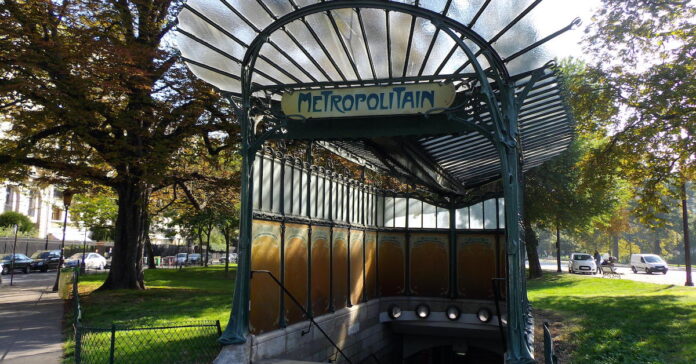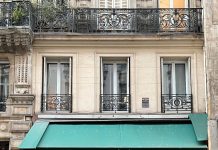For more than 100 years, the Paris metro has been at the heart of the city, and apart from getting you from A to B, some of the stations are also great places for catching up with some history and art. Having called Paris home for 6 years, I often walked to certain metro stops even if another was closer, simply because it was prettier.
There are more than 300 metro stations across Paris, reaching into the suburbs, and most are simply metro stations that allow you to catch a train. Others, though, are destinations in their own right, decorated to the hilt, often with special displays linked to the station’s name, while yet others have beautiful architecture that makes them stand out.
Here are some of my favorites for you to have a look at, with tips as to what’s to see outside of each station.
My absolute favorite, this station takes its name from the Musée des Arts et Metiers above.
(Photo Credit: RATP)
1. Arts Et Metiers
Metro Lines 3 And 11
My absolute favorite, this station takes its name from the Musée des Arts et Metiers above. First opened in 1906, the station was redesigned in 1994 by Belgian artist François Schuiten, who is known for his futuristic architecture and fantasy-inspired graphic novels. The station’s line 11 platforms are now a superbly futuristic, fully copper-clad submarine complex, complete with portholes, reminiscent of Jules Verne’s adventures and a perfect link to the inventions found in the museum.
Pro Tip: The Musée des Arts et Metiers is a not-to-be-missed exhibition of scientific inventions, including the original Foucault pendulum, demonstrating the rotation of the Earth; the first model of the Statue of Liberty; and numerous trains, planes, and automobiles, all housed in a couple of fantastic buildings.

(Photo Credit: Ulrike Lemmin-Woolfrey)
2. Abbesses
Line 12
Abbesses is a beauty from its start to its end. The entrance to the metro station is a wonderful original Art Nouveau one, and all the platforms are tiled beautifully. But for the real treat, you must forgo the elevator of this, one of Paris’s deepest metro stations. You’ll be rewarded with large water-color murals along the winding staircase on the way up, and large photographs of the area on the way down. The metro platforms lie five floors down, but you can catch your breath looking at the art, and rest assured that you worked off that croissant you had for breakfast.
Pro Tip: You are welcomed by Le mur des je t’aime (the wall of love) above, in the small Jehan Rictus Garden, plus an old-fashioned carousel and the nearby funicular railway up to Sacre Coeur and Montmartre.

(Photo Credit: Ulrike Lemmin-Woolfrey)
3. Porte Dauphine
Line 2
This has hands down the prettiest entrance of all 300+ metro stations. The original Art Nouveau entrance fans out above a glass-clad structure and comes complete with the architect Hector Guimard’s “signature’” on the iconic metro sign. Standing at the end of Avenue Foch, the greenest of the grand avenues leading to the Arc de Triomphe, it was named after a former city gate, Porte Dauphine, and has been dedicated as a national monument.
Pro Tip: From here you can walk to the Bois de Boulogne, the vast forest on Paris’s doorstep, or saunter down Avenue Foch toward the Arc de Triomphe, looking at the amazing real estate all around. I have already chosen a few favorites.

(Photo Credit: Ulrike Lemmin-Woolfrey)
4. Bastille
Lines 1, 5, And 8
Line 1 and 5’s platforms have something to offer: On the platform for line 5, direction Bobigny, are remains of the original Bastille building. Line 1, direction La Defense, offers countless tiled depictions of France’s history, including the storming of the Bastille, while in the direction Chateau des Vincennes, the outdoor platform has lovely views across the Canal Saint-Martin with its moored houseboats and barges.
Pro Tip: Where the Bastille once stood is now a gigantic roundabout complete with July Column topped with a golden-winged Genie de la Liberté (Spirit of Freedom). There is the modern Paris Opera building, plenty of cafes and restaurants, and a superb twice-weekly market (Thursday and Sunday mornings from 7 a.m. to 2:30 p.m.).

(Photo Credit: RATP)
5. Cluny – La Sorbonne
Line 10
On the ceiling of the platform is the 4,300-square-foot Les Oiseaux (The Birds) mosaic by Jean Bazaine, surrounded by the signatures of 50 luminaries who lived and worked around the Latin Quarter and influenced French history. There are signatures of, for example, Richelieu, Louis XIV, Baudelaire, Sartre, Balzac, Descartes, Victor Hugo, Moliere, and Robespierre.
Pro Tip: The ancient university of La Sorbonne, with its many faculties, and the Museé de Cluny give the station its name. The Musée de Cluny is also known as the Musée national du Moyen Âge, that is, the National Museum of the Middle Ages. Built on and around ruins from Gallo-Roman baths, the museum houses impressive collections of artifacts from the Middle Ages, including the renowned tapestries of the Lady of the Unicorn from around 1500.

(Photo Credit: Ulrike Lemmin-Woolfrey)
6. Louvre-Rivoli
Line 1
This station, one of the stops close to the Louvre, acts as a taster of what the museum will offer you. Brimming with (replica) exhibits from the above Louvre Museum standing in the alcoves, you can see the Venus de Milo, various exhibits from ancient Egypt, the goddess Diana, and more. You will get so engrossed that you will miss a few trains, I am sure.
Hop off here to reach the Seine, with both the Pont des Arts and Pont Neuf close by, and for a shopping trip down Rue Rivoli.
Pro Tip: The entrance to the next Louvre metro stop, Palais Royal – Musée du Louvre, has, at the Place Collette exit, a lovely bauble-studded entrance, called the Kiosque des Noctambules, an art installation by Jean-Michel Othoniel. Exit here to visit the beautiful Palais Royal gardens.

(Photo Credit: RATP)
7. Concorde
Lines 1, 8, And 12
One of Paris’s oldest stations, opened in 1900, the platforms of line 12 are entirely covered in tiles spelling out the Déclaration des Droits de l’Homme et du Citoyen, that is, the Declaration of the Rights of Man and the Citizen, from the French Revolution in 1789. Artist Françoise Schein finished the project between 1989 and 1991, using 44,000 tiles. As all punctuation was left out, it makes for an interesting word puzzle while waiting for the next train.
Pro Tip: Place de la Concorde, the vast square between the Champs Elysées and the Tuileries Gardens lies just above. There is one of the Obelisks of Luxor, the fantastic l’Orangerie museum, and spectacular views across the square to the Arc de Triomphe and the Eiffel Tower.
8. Liege
Line 13
This station was initially called Berlin, after rue de Berlin. In late 1914, after the valiant resistance of the Belgians at the Battle of Liege, both the road and the station were named Liege. It was not until 1982, though, that the station was redecorated with blue and white ceramic tiles depicting scenes of rural life in the province of Liege. What is peculiar to this station is that in one spot, the tunnel was not wide enough to accommodate trains going in both directions, so the platforms lie behind one another along the line and can be seen through the tunnel.
Pro Tip: Above you’ll find a bustling residential area full of cafes and individual shops, plus plenty of small hotels.

(Photo Credit: Ulrike Lemmin-Woolfrey)
9. Pont-Neuf – La Monnaie
Line 7
The walls of the platforms are covered in large reproductions of historical coins from around the world, hinting at the presence of the French Mint near the station. There are also large money-weighing scales and several glass cases showing coins and their history.
Pro Tip: Above, you’ll find Pont Neuf, which despite, the name is one of Paris’s oldest bridges, and across said bridge is one of the buildings of Le Monnaie, the French Mint. Inside permanent and changing exhibitions tell the story of money.
10. Bibliotèque François-Mitterand
Line 14
This is no old-fashioned Paris metro stop, but a modern public transport hub. Here, as befits the name, the theme of letters and learning is carried through the station. The platforms, in both directions, are randomly dotted with 180 small brass plaques with quotations from authors — a perfect way to test your knowledge of both the French language and world literature. Up from the metro platforms, the wide staircase is inscribed with the numbers 1 to 19 in 19 different alphabets. The mind boggles but is left somewhat unsatisfied as to which languages are depicted.
Pro Tip: Despite still being Paris proper, this is a modern, young, and lively place, full of shops and cafes around the gigantic library and university buildings. Nearby, along the Seine, there are theatres and café barges, even one that is a swimming pool, plus a selection of restaurants on the quayside.
Paris Metro: American Flag Edition
Feeling homesick for the States? Emerge from metro line 7 at Cadet and you’ll find an enormous depiction of an American flag design tiled across the station. The flag features the 13 stars in a circle — a copy of the Betsy Ross Flag of the American Revolutionary War.










